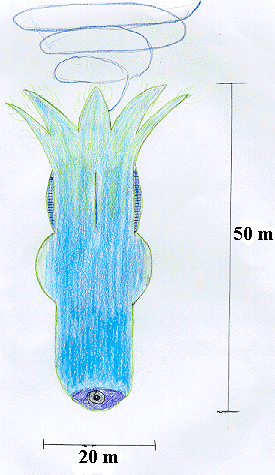

As you can see, the immense girth of this impressive monster can at least in part account for extensive destruction that it is capable of causing. This "mother of all cephaglobinids" measures over 50 meters in length and 20 meters in both width and thickness. The dry mass of the seaswallower has yet to be weighed, although it is estimated to be upwards of 70 tons. It is blue in color, although it has this sort of eerie green glow about it, probably a result of its diet. The seaswallower has a very unique mode of locomotion. What appears to be it's bottom is actually the anterior, which contains a jet like propulsion mechanism (to be discussed later). To counteract this effect and keep the animal from "up-ending" itself and moving in circles, it has four compensating lateral fins that keep the beast upright as it moves along, almost in a stepwise fashion. Just below the fins is a wide medial bulge, which is the source of the whirlpool. Finally, one of its primary sensory systems consisted of tiny, fine tentacles on the posterior ends of the animal, much resembling that of a squid or jellyfish. These tentacles are capable of picking up the slightest change in temperature or current.
The most fascinating feature of the seaswallower, however, is without a doubt the mechanism by which it generates a whirlpool. The spinner, which is located approximately in the center of the body, works in close association with the spinal column, brain, and sonar transmitter to generate the deadly vortex. A cross-sectional view of the cephaglobinid is quite demonstrative in understanding the internal mechanisms of the animals survival.